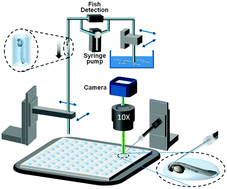Organ-targeted high-throughput in vivo biologics screen identifies materials for RNA delivery†
Abstract
Therapies based on biologics involving delivery of proteins, DNA, and RNA are currently among the most promising approaches. However, although large combinatorial libraries of biologics and delivery vehicles can be readily synthesized, there are currently no means to rapidly characterize them in vivo using animal models. Here, we demonstrate high-throughput in vivo screening of biologics and delivery vehicles by automated delivery into target tissues of small vertebrates with developed organs. Individual zebrafish larvae are automatically oriented and immobilized within hydrogel droplets in an array format using a microfluidic system, and delivery vehicles are automatically microinjected to target organs with high repeatability and precision. We screened a library of lipid-like delivery vehicles for their ability to facilitate the expression of protein-encoding RNAs in the central nervous system. We discovered delivery vehicles that are effective in both larval zebrafish and rats. Our results showed that the in vivo zebrafish model can be significantly more predictive of both false positives and false negatives in mammals than in vitro mammalian cell culture assays. Our screening results also suggest certain structure–activity relationships, which can potentially be applied to design novel delivery vehicles.


 Please wait while we load your content...
Please wait while we load your content...